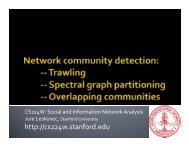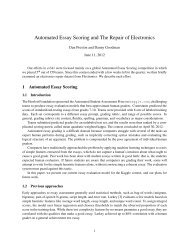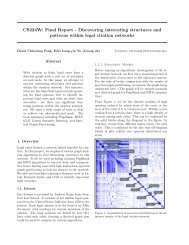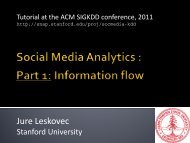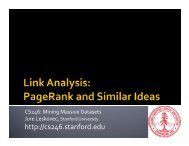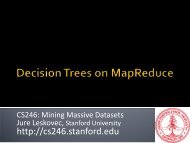Slides - SNAP - Stanford University
Slides - SNAP - Stanford University
Slides - SNAP - Stanford University
You also want an ePaper? Increase the reach of your titles
YUMPU automatically turns print PDFs into web optimized ePapers that Google loves.
CS224W: Social and Information Network Analysis<br />
Jure Leskovec, <strong>Stanford</strong> <strong>University</strong><br />
http://cs224w.stanford.edu
What is the typical shortest path<br />
length between any two people?<br />
Experiment on the global soc. network<br />
Can’t measure, need to probe explicitly<br />
Small-world experiment [Milgram ’67]<br />
Picked 300 people in Omaha, Nebraska<br />
and Wichita, Kansas<br />
Task: Get a letter to a Boston stockbroker<br />
by passing it through friends<br />
How many steps did it take?<br />
It took 6.2 steps on the average,<br />
thus “6 degrees of separation”<br />
10/6/2011 Jure Leskovec, <strong>Stanford</strong> CS224W: Social and Information Network Analysis, http://cs224w.stanford.edu 2
(1) What is the structure of a social network?<br />
(2) Which mechanisms do people use to route<br />
and find the target?<br />
10/6/2011 Jure Leskovec, <strong>Stanford</strong> CS224W: Social and Information Network Analysis, http://cs224w.stanford.edu 3
Assume each human is connected to 100 other people.<br />
Then:<br />
Step 1: reach 100 people<br />
Step 2: reach 100*100 = 10,000 people<br />
Step 3: reach 100*100*100 = 1,000,000 people<br />
Step 4: reach 100*100*100*100 = 100M people<br />
In 5 steps we can reach 10 billion people<br />
What’s wrong here?<br />
92% of new FB friendships are to a friend-of-a-friend<br />
10/6/2011 Jure Leskovec, <strong>Stanford</strong> CS224W: Social and Information Network Analysis, http://cs224w.stanford.edu 4
10/6/2011 Jure Leskovec, <strong>Stanford</strong> CS224W: Social and Information Network Analysis, http://cs224w.stanford.edu 5
MSN network has 7 orders of magnitude<br />
larger clustering than the corresponding G np!<br />
Other examples:<br />
Actor Collaborations (IMDB): 225,226 nodes, avg. degree k=61<br />
Electrical power grid: 4,941 nodes, k=2.67<br />
Network of neurons 282 nodes, k=14<br />
L ... Average shortest path length<br />
C ... Average clustering coefficient<br />
10/6/2011 Jure Leskovec, <strong>Stanford</strong> CS224W: Social and Information Network Analysis, http://cs224w.stanford.edu 6
Consequence of expansion:<br />
Short paths: O(log n)<br />
This is the “best” we can<br />
do if the graph has constant<br />
degree and n nodes<br />
But networks have<br />
local structure:<br />
Triadic closure:<br />
Friend of a friend is my friend<br />
How can we have both?<br />
Pure exponential growth<br />
Triadic closure reduces growth rate<br />
10/6/2011 Jure Leskovec, <strong>Stanford</strong> CS224W: Social and Information Network Analysis, http://cs224w.stanford.edu 7
Where should we place social networks?<br />
Clustered? Random?<br />
10/6/2011 Jure Leskovec, <strong>Stanford</strong> CS224W: Social and Information Network Analysis, http://cs224w.stanford.edu 8
Could a network with high clustering be at<br />
the same time a small world?<br />
How can we at the same time have<br />
high clustering and small diameter?<br />
High clustering<br />
High diameter<br />
Clustering implies edge “locality”<br />
Randomness enables “shortcuts”<br />
Low clustering<br />
Low diameter<br />
10/6/2011 Jure Leskovec, <strong>Stanford</strong> CS224W: Social and Information Network Analysis, http://cs224w.stanford.edu 9
Small-world Model [Watts-Strogatz ‘98]:<br />
2 components to the model:<br />
(1) Start with a low-dimensional regular lattice<br />
Has high clustering coefficient<br />
Now introduce randomness (“shortucts”)<br />
(2) Rewire:<br />
Add/remove edges to create<br />
shortcuts to join remote parts<br />
of the lattice<br />
For each edge with prob. p move<br />
the other end to a random node<br />
[Watts-Strogatz Nature ‘98]<br />
10/6/2011 Jure Leskovec, <strong>Stanford</strong> CS224W: Social and Information Network Analysis, http://cs224w.stanford.edu 10
High clustering<br />
High diameter<br />
N<br />
h = C =<br />
2k<br />
3<br />
4<br />
High clustering<br />
Low diameter<br />
[Watts-Strogatz Nature ‘98]<br />
Low clustering<br />
Low diameter<br />
log N<br />
h =<br />
C =<br />
logα<br />
Rewiring allows us to interpolate between regular<br />
lattice and a random graph<br />
10/6/2011 Jure Leskovec, <strong>Stanford</strong> CS224W: Social and Information Network Analysis, http://cs224w.stanford.edu 11<br />
k<br />
N
Clustering coefficient, C = 1/n ∑ C i<br />
Parameter region of high<br />
clustering and low diameter<br />
Prob. of rewiring, p<br />
It takes a lot of<br />
randomness to ruin<br />
the clustering, but a<br />
very small amount<br />
to overcome locality.<br />
10/6/2011 Jure Leskovec, <strong>Stanford</strong> CS224W: Social and Information Network Analysis, http://cs224w.stanford.edu 12
Alternative formulation of the model:<br />
Start with a square grid<br />
Each node has 1 random long-range edge<br />
Each node has 1 spoke. Then randomly connect them.<br />
C i ≥ 2*12/(8*7) ≥ 0.43<br />
What’s the diameter?<br />
It is log(n)<br />
Why?<br />
10/6/2011 Jure Leskovec, <strong>Stanford</strong> CS224W: Social and Information Network Analysis, http://cs224w.stanford.edu 13
Proof:<br />
Consider a graph where we contract<br />
2x2 subgraphs into supernodes<br />
Now we have 4 edges sticking out of<br />
each supernode<br />
4-regular random graph!<br />
From Thm. we have short paths<br />
between super nodes<br />
We can turn this into a path in a real<br />
graph by adding at most 2 steps per<br />
hop<br />
⇒Diameter of the model is<br />
O(2 log n) i.e. short paths exist!<br />
4-regular random<br />
graph<br />
10/6/2011 Jure Leskovec, <strong>Stanford</strong> CS224W: Social and Information Network Analysis, http://cs224w.stanford.edu 14
Could a network with high clustering be at<br />
the same time a small world?<br />
Yes. You don’t need more than a few random links.<br />
The Watts Strogatz Model:<br />
Provides insight on the interplay between<br />
clustering and the small-world<br />
Captures the structure of many realistic networks<br />
Accounts for the high clustering of real networks<br />
Does not lead to the correct degree distribution<br />
Does not enable navigation (next lecture)<br />
10/6/2011 Jure Leskovec, <strong>Stanford</strong> CS224W: Social and Information Network Analysis, http://cs224w.stanford.edu 15
(1) What is the structure of a social network?<br />
(2) What strategies do people use to route<br />
and find the target?<br />
How would you go about finding the path?<br />
10/6/2011 Jure Leskovec, <strong>Stanford</strong> CS224W: Social and Information Network Analysis, http://cs224w.stanford.edu 16
s only knows locations of its friends<br />
and location of the target t<br />
s does not know links of anyone but itself<br />
Geographic Navigation:<br />
s navigates to the node closest to t<br />
Search time T: Number of steps to reach t<br />
s<br />
10/6/2011 Jure Leskovec, <strong>Stanford</strong> CS224W: Social and Information Network Analysis, http://cs224w.stanford.edu 17<br />
t
Searchable<br />
Search time:<br />
O((logn)<br />
β<br />
Kleinberg’s model<br />
2<br />
O((logn)<br />
)<br />
)<br />
Not searchable<br />
( )<br />
α<br />
O n<br />
Watts-Strogatz<br />
( 3<br />
2<br />
n<br />
O(n<br />
10/6/2011 Jure Leskovec, <strong>Stanford</strong> CS224W: Social and Information Network Analysis, http://cs224w.stanford.edu 18<br />
O<br />
)<br />
)<br />
Erdős–Rényi
Model: 2-dim grid where each node has one<br />
random edge<br />
This is a small-world<br />
Fact: A decentralized search algorithm in<br />
Watts-Strogatz model needs N 2/3 steps to<br />
reach t in expectation<br />
Note: even though paths of O(log N) steps exist<br />
10/6/2011 Jure Leskovec, <strong>Stanford</strong> CS224W: Social and Information Network Analysis, http://cs224w.stanford.edu 19
Let’s do the proof for 1-dimensional case<br />
About the proof:<br />
Setting: n nodes on a ring<br />
plus one random directed<br />
edge per node.<br />
Search time is now O(n1/2 )<br />
For d-dim. case: ~ nd/(d+1) s<br />
t<br />
Proof strategy: Principle of deferred decision<br />
Doesn’t matter when a random decision is made if you<br />
haven’t seen it yet<br />
Assume random long range links are only created once<br />
you get to them<br />
10/6/2011 Jure Leskovec, <strong>Stanford</strong> CS224W: Social and Information Network Analysis, http://cs224w.stanford.edu 20
Claim:<br />
Expected search time is ≥ n 1/2<br />
Let: E i= event that long link out<br />
of node i points to some node<br />
in interval I of width 2x nodes<br />
Then: P(Ei)= 2x/n<br />
(haven’t seen node i yet, but can<br />
assume random edge generation)<br />
Let: E=event that any of first k<br />
nodes you see has a link to I:<br />
Then:<br />
k<br />
k ⎛ ⎞<br />
P(<br />
E)<br />
= P⎜<br />
Ei<br />
⎟ ≤ ∑ P(<br />
Ei<br />
) =<br />
⎝ i ⎠ i<br />
2kx<br />
n<br />
10/6/2011 Jure Leskovec, <strong>Stanford</strong> CS224W: Social and Information Network Analysis, http://cs224w.stanford.edu 21<br />
s<br />
i<br />
k<br />
x<br />
I<br />
x<br />
t
Prob. of link to I:<br />
2kx<br />
Need k, x s.t. < 1<br />
n<br />
1<br />
Choose: k = x = 2 n<br />
So,<br />
P(<br />
E)<br />
=<br />
2<br />
( ) 1 n<br />
P(<br />
E)<br />
≤<br />
Suppose initial s is outside I<br />
and E does not happen.<br />
2<br />
n<br />
2kx<br />
n<br />
Then the search algorithm must<br />
take ≥ min(k, x) steps to get to t<br />
2<br />
=<br />
1<br />
2<br />
Case when:<br />
T ≥ k<br />
10/6/2011 Jure Leskovec, <strong>Stanford</strong> CS224W: Social and Information Network Analysis, http://cs224w.stanford.edu 22<br />
x<br />
s<br />
t<br />
k<br />
Case when:<br />
T ≥ x<br />
x<br />
s<br />
t<br />
k
Claim: Getting from s to t takes ≥
Watts-Strogatz graphs<br />
are not searchable<br />
How do we make a<br />
searchable small-world<br />
graph?<br />
Intuition:<br />
Our long range links<br />
are not random<br />
They follow geography!<br />
Saul Steinberg, “View of the World from 9th Avenue”<br />
10/6/2011 Jure Leskovec, <strong>Stanford</strong> CS224W: Social and Information Network Analysis, http://cs224w.stanford.edu 24
Model [Kleinberg, Nature ‘01]<br />
Nodes still on a grid<br />
Node has one long range link<br />
Prob. of long link to node v:<br />
P(u→v)
1-dim case:<br />
Claim: For α=1 we can get from s<br />
to t in O(log(n) 2 ) steps<br />
Set:
We need to calculate:<br />
P(v<br />
→<br />
w)<br />
=<br />
d(v, w)<br />
d(v, u)<br />
∑<br />
u≠v<br />
What is the normalizing const?<br />
n / 2<br />
-<br />
1<br />
∑<br />
1<br />
1<br />
d(u,v) = ∑<br />
−<br />
2d<br />
= 2∑<br />
all possible d<br />
u≠v<br />
n / 2<br />
∑<br />
d = 1<br />
1<br />
d<br />
≤1<br />
+<br />
n / 2<br />
∫<br />
1<br />
dx<br />
x<br />
distances d<br />
from1<br />
→n/2<br />
n<br />
= 1+<br />
ln( )<br />
2<br />
-1<br />
=<br />
-1<br />
ln n<br />
d = 1<br />
2ln<br />
10/6/2011 Jure Leskovec, <strong>Stanford</strong> CS224W: Social and Information Network Analysis, http://cs224w.stanford.edu 27<br />
≤<br />
n<br />
d/2<br />
v<br />
d/2<br />
t<br />
d
We need P(v points to I)=<br />
P(<br />
v<br />
points<br />
1<br />
= ∑ 2ln<br />
n w∈I<br />
to<br />
I)<br />
=<br />
∑<br />
w∈I<br />
1<br />
d(<br />
v,<br />
w)<br />
All terms<br />
≥ 2/(3d)<br />
P(v<br />
→<br />
1<br />
≥ d<br />
2ln<br />
n<br />
w)<br />
∑<br />
w∈I<br />
10/6/2011 Jure Leskovec, <strong>Stanford</strong> CS224W: Social and Information Network Analysis, http://cs224w.stanford.edu 28<br />
≥<br />
2<br />
3d<br />
=<br />
1<br />
3ln<br />
d(v, w)<br />
2ln<br />
n<br />
n<br />
-1<br />
d/2<br />
Note:<br />
d(v,x)=3d/2 x<br />
v<br />
d/2<br />
t<br />
d
We have:<br />
I ... interval of d/2 around t (where d=d(s,t))<br />
P(long link of v points to I)=1/ln(n)<br />
In expected # of steps ≤ ln(n)<br />
you get into I, and you thus<br />
halve the distance to t<br />
Distance can be halved at<br />
most log 2(n) times, so<br />
expected time to reach t:<br />
O(ln(n)⋅log 2(n)) = O(log(n) 2 )<br />
10/6/2011 Jure Leskovec, <strong>Stanford</strong> CS224W: Social and Information Network Analysis, http://cs224w.stanford.edu 29<br />
d/2<br />
v<br />
d/2<br />
t<br />
d
We know:<br />
α=0 (i.e., Watts-Strogatz): we need
Small α: too many long links Big α: too many short links<br />
Demo: http://projects.si.umich.edu/netlearn/NetLogo4/SmallWorldSearch.html<br />
10/6/2011 Jure Leskovec, <strong>Stanford</strong> CS224W: Social and Information Network Analysis, http://cs224w.stanford.edu 31
How does the argument change for 2-d grid:<br />
P(u→v) >1/Z ⋅ size(I) ⋅ Prob on each node<br />
logn<br />
Why P(u→v) ~ d(u,v) -dim works?<br />
Approx uniform over all<br />
“scales of resolution”<br />
# points at distance d grows<br />
as d dim , prob. d -dim of each edge<br />
const. prob. of a link,<br />
independent of d<br />
d<br />
2<br />
−2<br />
d ⇒ α=2<br />
10/6/2011 Jure Leskovec, <strong>Stanford</strong> CS224W: Social and Information Network Analysis, http://cs224w.stanford.edu 32
h(u,v) = tree-distance<br />
(height of the least common ancestor)<br />
-α h(u,v)<br />
P(u→v) ~ b<br />
P(u→v) is approx uniform<br />
at all scales of resolution<br />
How many nodes are<br />
at dist. h? (b-1)bh-1 ~ bh So we need b-h to cancel, as we<br />
wanted for distance independence<br />
Start at s, want to go to t<br />
Only see out links of node you are at<br />
Have knowledge of where t is in the tree<br />
10/6/2011 Jure Leskovec, <strong>Stanford</strong> CS224W: Social and Information Network Analysis, http://cs224w.stanford.edu 33<br />
Hierarchy<br />
Nodes/Edges of the network<br />
Tree distance
Nodes are in the leaves of a<br />
tree:<br />
Departments, topics, …<br />
Create k edges out of a node<br />
Create i-th (i=1…k) edge out<br />
of v by choosing v→w with<br />
prob. ~b -h(v,w)<br />
Claim 1:<br />
For any direct subtree T’ one of v’s<br />
links points to T’<br />
Claim 2:<br />
Claim 1 guarantees efficient search<br />
You will prove C1 & C2 in HW1<br />
Node has 1 link to each<br />
direct subtree<br />
10/6/2011 Jure Leskovec, <strong>Stanford</strong> CS224W: Social and Information Network Analysis, http://cs224w.stanford.edu 34
Extension:<br />
Multiple hierarchies – geography, profession, …<br />
Generate separate random graph in each hierarchy<br />
Superimpose the graphs<br />
Search algorithm:<br />
Choose a link that gets closest in any hierarchy<br />
Q: How to analyze the model?<br />
Simulations:<br />
Search works for a range of alphas<br />
Biggest range of searchable<br />
alphas for 2 or 3 hierarchies<br />
Too many hierarchies hurts<br />
[Watts-Dodds-Newman ‘02]<br />
10/6/2011 Jure Leskovec, <strong>Stanford</strong> CS224W: Social and Information Network Analysis, http://cs224w.stanford.edu 35<br />
Search Time<br />
α
Adamic-Adar 2005:<br />
HP Labs email logs (436 people)<br />
Link if u,v exchanged >5 emails each way<br />
Map of the organization hierarchy<br />
How many edges cross groups?<br />
Finding:<br />
P(u→v) ~ 1 / (social distance) 3/4<br />
Differences from the<br />
hierarchical model:<br />
Data has weighted edges<br />
Data has people on non-leaf nodes<br />
Data not b-ary or uniform depth<br />
Cubicle<br />
locations<br />
[Adamic-Adar 2005]<br />
CEO<br />
10/6/2011 Jure Leskovec, <strong>Stanford</strong> CS224W: Social and Information Network Analysis, http://cs224w.stanford.edu 37<br />
VPs
Generalized hierar. model:<br />
Arbitrary tree defines<br />
“groups” = rooted subtrees<br />
P(u→v) ~ 1 / (smallest group<br />
containing u,v)<br />
[Adamic-Adar 2005]<br />
Search strategies<br />
using degree,<br />
hierarchy, geo<br />
distance between<br />
the cubicles<br />
Prob. of link vs. distance in the hierarchy<br />
10/6/2011 Jure Leskovec, <strong>Stanford</strong> CS224W: Social and Information Network Analysis, http://cs224w.stanford.edu 38
Liben-Nowell et al. ’05:<br />
LiveJournal data<br />
Blogers + zip codes<br />
Link prob.: P(u,v)=δ -α<br />
α =?<br />
Problem:<br />
Not uniform population density<br />
Solution: Rank based friendship<br />
[Liben-Nowell et al. ‘05]<br />
Link length in a network of bloggers<br />
(0.5 million bloggers, 4 million links)<br />
10/6/2011 Jure Leskovec, <strong>Stanford</strong> CS224W: Social and Information Network Analysis, http://cs224w.stanford.edu 39
P(u→v) = rank u(v) -α<br />
What is best α?<br />
For equally spaced pairs: α=dim. of the space<br />
In this special case α=1 is best for search<br />
10/6/2011 Jure Leskovec, <strong>Stanford</strong> CS224W: Social and Information Network Analysis, http://cs224w.stanford.edu<br />
[Liben-Nowell et al. ‘05]<br />
40
Close to<br />
theoretical<br />
optimum of -1<br />
10/6/2011 Jure Leskovec, <strong>Stanford</strong> CS224W: Social and Information Network Analysis, http://cs224w.stanford.edu<br />
[Liben-Nowell et al. ‘05]<br />
The difference between<br />
the East and West coast<br />
disappears<br />
41
Decentralized search in a LiveJournal network<br />
12% searches finish, average 4.12 hops<br />
10/6/2011 Jure Leskovec, <strong>Stanford</strong> CS224W: Social and Information Network Analysis, http://cs224w.stanford.edu<br />
[Liben-Nowell et al. ‘05]<br />
42
Hitting the node is<br />
very hard. Very small<br />
fraction (4%) of runs<br />
hits the target after<br />
1000 steps.<br />
Deg*Age/Geo 2<br />
Deg/Geo 2<br />
Cntry*Deg<br />
Geo<br />
Language<br />
Degree<br />
Random<br />
10/6/2011 Jure Leskovec, <strong>Stanford</strong> CS224W: Social and Information Network Analysis, http://cs224w.stanford.edu 43
Getting close (10km) is<br />
very easy. Geographic<br />
navigation gets close in<br />
less than 15 steps 90%<br />
of the times.<br />
10/6/2011 Jure Leskovec, <strong>Stanford</strong> CS224W: Social and Information Network Analysis, http://cs224w.stanford.edu 44
Deg/Geo 2 gets close to<br />
the target (10km) with<br />
at most 2 hops 60% of<br />
the times<br />
10/6/2011 Jure Leskovec, <strong>Stanford</strong> CS224W: Social and Information Network Analysis, http://cs224w.stanford.edu 45
Why is rank exponent close to -1?<br />
Why in any network? Why online?<br />
How robust/reproducible?<br />
Mechanisms that get α=1 purely through local<br />
“rearrangements” of links<br />
Conjecture [Sandbeng-Clark 2007]:<br />
Nodes on a ring with random edges<br />
Process of morphing links:<br />
Update step: Randomly choose s, t, run decentr. search alg.<br />
Path compression: each node on path updates long range link<br />
to go directly to t with some small prob.<br />
Conjecture from simulation: P(u→v) ~ dist -1<br />
10/6/2011 Jure Leskovec, <strong>Stanford</strong> CS224W: Social and Information Network Analysis, http://cs224w.stanford.edu 46
Algorithmic consequence of<br />
small-world:<br />
How to find files in<br />
Peer-to-Peer networks?<br />
10/6/2011 Jure Leskovec, <strong>Stanford</strong> CS224W: Social and Information Network Analysis, http://cs224w.stanford.edu 48
10/6/2011 Jure Leskovec, <strong>Stanford</strong> CS224W: Social and Information Network Analysis, http://cs224w.stanford.edu 49
10/6/2011 Jure Leskovec, <strong>Stanford</strong> CS224W: Social and Information Network Analysis, http://cs224w.stanford.edu 50
Napster existed from<br />
June ‘99 and July ‘01<br />
Hybrid between P2P<br />
and a centralized<br />
network<br />
Once lawyers got the<br />
central server to shut<br />
down the network<br />
fell apart<br />
10/6/2011 Jure Leskovec, <strong>Stanford</strong> CS224W: Social and Information Network Analysis, http://cs224w.stanford.edu 51
Networks that can’t be turned “off”<br />
BitTorrent, ML-donkey, Kazaa, Gnutella<br />
Q: How to find a file in a network without a<br />
central server?<br />
First attempt: Freenet<br />
Random graph of peers who know each other<br />
Query: Find a file with key x, x∈[0,2 64 ]<br />
Algorithm:<br />
If node has it, done<br />
Forward query to node with a file having<br />
key y as close to x as possible: min y |x-y|<br />
If can’t forward, then backtrack.<br />
Cut off after some # of steps.<br />
Copy the key x along the path (path compression)<br />
10/6/2011 Jure Leskovec, <strong>Stanford</strong> CS224W: Social and Information Network Analysis, http://cs224w.stanford.edu 52
Protocol Chord consistently maps key<br />
(filename) to a node:<br />
Keys are files we are searching for<br />
Computer that keeps the key can then point to the<br />
true location of the file<br />
Keys and nodes have m-bit IDs assigned to<br />
them:<br />
Node ID is a hash-code of the IP address<br />
Key ID is a hash-code of the file<br />
10/6/2011 Jure Leskovec, <strong>Stanford</strong> CS224W: Social and Information Network Analysis, http://cs224w.stanford.edu 53
Cycle with node ids<br />
0 to 2 m-1<br />
File (key) k is<br />
assigned to a node<br />
a(k) with ID ≥ k<br />
N51<br />
N48<br />
N42<br />
N56<br />
K58<br />
N38<br />
K34<br />
N1<br />
m=6<br />
N32<br />
10/6/2011 Jure Leskovec, <strong>Stanford</strong> CS224W: Social and Information Network Analysis, http://cs224w.stanford.edu<br />
N8<br />
K24<br />
K30<br />
K10<br />
N21<br />
N14<br />
54
Assume we have N nodes and K keys (files)<br />
How many keys has each node?<br />
When a node joins/leaves the system it only<br />
needs to talk to its immediate neighbors<br />
When N+1 nodes join or leave, then only<br />
O(K/N) keys need to be rearranged<br />
Each node know the IP address of its<br />
immediate neighbor<br />
10/6/2011 Jure Leskovec, <strong>Stanford</strong> CS224W: Social and Information Network Analysis, http://cs224w.stanford.edu 55
If every node knows<br />
its immediate<br />
neighbor then use<br />
sequential search<br />
N51<br />
N48<br />
N42<br />
N56<br />
K58<br />
N38<br />
K34<br />
N1<br />
m=6<br />
N32<br />
10/6/2011 Jure Leskovec, <strong>Stanford</strong> CS224W: Social and Information Network Analysis, http://cs224w.stanford.edu<br />
N8<br />
K24<br />
K30<br />
K10<br />
N21<br />
N14<br />
56
A node maintains a table of m=log(N) entries<br />
i-th entry of a node n contains the address of<br />
(n+2 i )-th neighbor<br />
Problem: When a node joins we violate<br />
long range pointers of all other nodes<br />
Many papers about how to make this work<br />
Search algorithm:<br />
Take the longest link that does not overshoot<br />
This way with each step we half the distance to the<br />
target<br />
10/6/2011 Jure Leskovec, <strong>Stanford</strong> CS224W: Social and Information Network Analysis, http://cs224w.stanford.edu 57
N51<br />
N48<br />
N42<br />
N56<br />
N38<br />
N1<br />
N32<br />
10/6/2011 Jure Leskovec, <strong>Stanford</strong> CS224W: Social and Information Network Analysis, http://cs224w.stanford.edu 58<br />
N8<br />
N21<br />
N14<br />
N8+1 = N14<br />
N8+2 = N14<br />
N8+4 = N14<br />
N8+8 = N21<br />
N8+16 = N32<br />
N8+32 = N42
N42+1 = N48<br />
N42+2 = N48<br />
N42+4 = N48<br />
N42+8 = N51<br />
N42+16 = N1<br />
N42+32 = N8<br />
N51<br />
N48<br />
N42<br />
N56<br />
N38<br />
N1<br />
N32<br />
N8<br />
N21<br />
N14<br />
10/6/2011 Jure Leskovec, <strong>Stanford</strong> CS224W: Social and Information Network Analysis, http://cs224w.stanford.edu<br />
N8+1 = N14<br />
N8+2 = N14<br />
N8+4 = N14<br />
N8+8 = N21<br />
N8+16 = N32<br />
N8+32 = N42<br />
59
Search for a key in the network of N nodes<br />
visits O(log N) nodes<br />
Assume that node n queries for key k<br />
Let the key k reside at node t<br />
How many steps do we need to reach t?<br />
10/6/2011 Jure Leskovec, <strong>Stanford</strong> CS224W: Social and Information Network Analysis, http://cs224w.stanford.edu 60
We start the search at node n<br />
Let i be a number such that t is contained in<br />
interval [n+2 i-1 , n+2 i ]<br />
Then the table at node n contains a pointer to<br />
node n+2 i-1 – the smallest node f from the<br />
interval<br />
Claim: f is closer to t than n<br />
So, in one step we halved the distance to t<br />
We can do this at most log N times<br />
Thus, we find t in O(log N) steps<br />
10/6/2011 Jure Leskovec, <strong>Stanford</strong> CS224W: Social and Information Network Analysis, http://cs224w.stanford.edu 61





